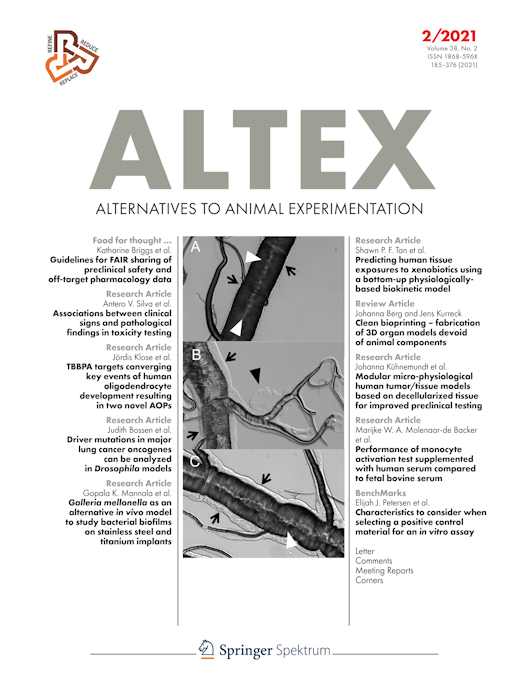How a GIVIMP certification program can increase confidence in in vitro methods
Main Article Content
Article Details

This work is licensed under a Creative Commons Attribution 4.0 International License.
Articles are distributed under the terms of the Creative Commons Attribution 4.0 International license (http://creativecommons.org/licenses/by/4.0/), which permits unrestricted use, distribution and reproduction in any medium, provided the original work is appropriately cited (CC-BY). Copyright on any article in ALTEX is retained by the author(s).
Bas, A., Burns, N., Gulotta, A. et al. (2021). Understanding the development, standardization, and validation process of alternative in vitro test methods for regulatory approval from a researcher perspective. Small, e2006027. Online ahead of print. doi:10.1002/smll.202006027
Coecke, S., Balls, M., Bowe, G. et al. (2005). Guidance on good cell culture practice – a report of the second ECVAM task force on good cell culture practice. Altern Lab Anim 33, 261- 287. doi:10.1177/026119290503300313
Cooper-Hannan, R., Harbell, J. W., Coecke, S. et al. (1999). The principles of good laboratory practice: Application to in vitro toxicology studies. The report and recommendations of ECVAM Workshop 37. Altern Lab Anim 27, 539-577. doi:10.1177/026119299902700410
OECD (1998). OECD Principles on Good Laboratory Practice. OECD Series on Principles of Good Laboratory Practice and Compliance Monitoring, No. 1. OECD Publishing, Paris. doi:10.1787/9789264078536-en
OECD (2004). The Application of the Principles of GLP to In Vitro Studies. OECD Series on Principles of Good Laboratory Practice and Compliance Monitoring, No. 14. OECD Publishing, Paris. doi:10.1787/9789264084971-en
OECD (2018). Guidance Document on Good In Vitro Method Practices (GIVIMP). OECD Series on Testing and Assessment, No. 286. OECD Publishing, Paris. doi:10.1787/9789264304796-en
Pamies, D., Leist, M., Coecke, S. et al. (2020). Good cell and tissue culture practice 2.0 (GCCP 2.0) – Draft for stakeholder discussion and call for action. ALTEX 37, 490-492. doi:10.14573/altex.2007091
Patterson, E., Whelan, M. and Worth, A. (2021). The role of validation in establishing the scientific credibility of predictive toxicology approaches intended for regulatory application. Comput Toxicol 17, 100144. doi:10.1016/j.comtox.2020.100144
Urbisch, D., Mehling, A., Guth, K. et al. (2015). Assessing skin sensitization hazard in mice and men using non-animal test methods. Regul Toxicol Pharmacol 71, 337-351. doi:10.1016/j.yrtph.2014.12.008
Zuang V., Dura A. et al. (2019). EURL ECVAM status report on the development, validation and regulatory acceptance of alternative methods and approaches. EUR 30100 EN. Publi-cations Office of the European Union, Luxembourg, 2020, 77- 78. doi:10.2760/25602


